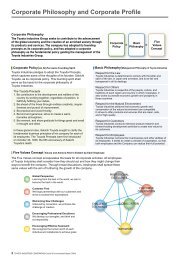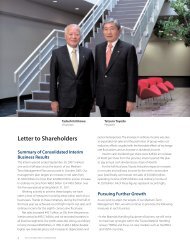toyoda textile machinery bulletin toyoda textile machinery bulletin
toyoda textile machinery bulletin toyoda textile machinery bulletin
toyoda textile machinery bulletin toyoda textile machinery bulletin
You also want an ePaper? Increase the reach of your titles
YUMPU automatically turns print PDFs into web optimized ePapers that Google loves.
TOYODATEXTILE MACHINERYBULLETINVol. 11The Sapporo Snow FestivalSpecial Feature2-3LW600 Series Water Jet Loom Special FeatureWhat’s New4SDM100 Air-Jet Automatic Drawing-In MachineTechnical Information5Toyoda Electronic Shedding MotionCustomer Support & Servise6A Look at Toyoda’s Global Service CentersPart 5: India Service Center (KTTM)Thoughts & Feelings7User Report Part 10: Shin Heung Textile Co., Ltd., KOREAManagement for the 21st Century8A Special SeminarThe “Toyota Production System” - Imbued with Resourcefulness: The Final Installment
LW 600 Series Water Jet Loom Special FeatureNew LW600 Model to StaProduction in FebruaryGreetings and Happy New Year to you, our valued customer.I hope that 1999 was a profitable year for you and that2000 will be even more prosperous.The past year saw the US economy continue its stronggrowth and the countries of Europe show gradualimprovement. While not all countries in Asia are progressingat the same rate, there is an overall trend towards economicrecovery. Japan’s economy is showing signs ofimprovement as the country aims to boost its internationalcompetitiveness by restructuring at both the corporate andindustry levels. The <strong>textile</strong> industry, however, isexperiencing a worldwide recession, despite signs ofimprovement in Korea and Taiwan. This has naturally hadrepercussions in the <strong>textile</strong> <strong>machinery</strong> industry.Against this background, we acquired Nissan’s water jetloom business last year, a move aimed at strengtheningand expanding our <strong>textile</strong> <strong>machinery</strong> business. We alsoadopted three principles that guide us in our work and thatdescribe our commitment to making quality the heart ofour business. These principles are to never produce aninferior product, to take responsibility to immediately fixthe problem if a defect is found, and to listen carefully towhat our customers have to say. Another important aspectof our quality commitment is having every member of theTextile Machinery Division look at things from thecustomer’s standpoint.Despite our successes in the past, we know that there arestill many areas in which we need to work harder. Our goalthis year— like every other year— is to provide greatercustomer satisfaction than ever before.The new water jet loom Toyoda announced in 1999 is finallyentering full production as of February, 2000.More than 100,000 water jet looms have been shipped tocustomers around the world. Based on extensive feedbackprovided by these customers, and with a goal of weaving highquality fabrics at high speeds at the lowest possible cost, Toyodais introducing the new LW600 Series Water Jet Looms featuringadvanced electronic controls originally developed for Toyoda’sbest selling JAT610 Air Jet Looms.FiveMajor Features of theLW600 Series1 Total Commitment to Improved QualityThe LW600 features electronic let-off motionas standard equipment. Electronic let-off inconjunction with a newly developedautomatic pick finding system achieves theoptimum in warp yarn control, sharplyreducing start marks and ensuring superiorfabric quality. Plus, improved jetting waterconcentration minimizes warp yarn damagein concert with high-speed operation.Electronic let-off motionAs we reach for greater heights in this pivotal year of thenew millennium, let us keep in mind the timeless words ofour founder, Sakichi Toyoda: “Open your doors to the greatbig world outside” and “Stay ahead of global trends throughdedication to technology and creativity.”Finally, I would like to thank you for choosing Toyodaproducts. I wish you and your family all the best in healthand happiness in 2000 and hope that this year will be yourbest ever.New nozzle2 Easier Operation and HandlingThe newly developed Automatic Pick Finder (APF) allows weavers to easilyrestart looms. In addition, electronic let-off and take-up motion plus anelectronic feeder measuring device mean significantly improved ease ofoperation. A newly developed operation panel makes entering requiredsettings simple and efficient.2Tatsuo MatsuuraManaging Director, Member of the BoardGeneral ManagerTextile Machinery Division
t20003 Lower Operating CostRD measuring is improved by adopting aturboblower as its standard for fasteroperation. Furthermore, modified yarnrouting in the RD feeder measuring devicemeans high-quality woven fabrics evenwhen weaving fine denier yarn or taffetasat high speeds.In addition, an electronic feedermeasuring device is optionally available onsingle-feeder measuring, offering significantenergy savings since no blower motor isrequired. Precise angle control and weftlength measurements facilitate lower waterconsumption and a reduction in weft wastefor major cost savings.Rotary drum feeder measuring device4 Rigid Frame Construction and Improved PaintA new design for the frame supporting electronic motion devices reducesvibration during high-speed operation, ensuring the highest level of fabricquality. In addition, a new painting promises high quality with a long, stableservice life.5 Expanded Weaving RangeFeeder measuring deviceA full suite of options facilitates weaving of heavy and higher density fabrics withstability. The new LW600 Series is capable of handling a broader range of fabrics,including those woven with several different types of yarns with various yarncounts, making it possible to weave value-added fabrics.■ Double Pump SystemThe Double Pump System adds versatilityand stability for two different wefts. Thissystem can also be used for similar weftyarns woven at high speed. Optimuminsertion conditions can be achieved oneach nozzle.■ Slanted Cloth Line / S-WrapTake-Up (LW603)Slanted cloth line is available for unbalanceddobby fabrics. The combinationDouble pumpof S-wrap cloth line and tention bar is effective in reducing beat-up onheavyweight or high-density fabrics. Rigidity of breast beam is enhanced.■ Heavy Fabric SpecificationEnhanced rigidity of let-off facilitates stable weaving of medium to heavyfabric including air bag and high-tention fabrics (up to 800 kg).■ Positive EasingPositive easing is synchronized with the shedding motion and is especiallyeffective for heavy, high-density fabrics where strong beat-up is required.■ Stretch Yarn Weaving SpecificationsReducing the distance between the gripper and nozzle prevents unthreadingof the nozzle. Weft pusher grips weft yarn to prevent slack picks.■ Independent Catch Cord SheddingTwo additional heald frames nomally required to weave the catch cordare now available for weaving the body cloth. A full 16 frames are availableon dobby machines for weaving body cloth.
Special Feature: SDM100 Air-Jet Automatic Drawing-In MachineSDM100, a Drawing-In Machinethat Uses Compressed Air to DrawWarp Yarns into Three DifferentHarnesses, Now Availablel!The Toyoda SDM100 Air-Jet Automatic Drawing-In Machine,which already enjoys an impressive record of performancewith glass fibers, can now handle a wide range of yarns.In addition to delivering remarkable improvements inproductivity, quality and labor savings in the drawing-in process,the SDM100 meets today’s weaving demands such as theability to handle multi-variety/small-lot orders and shortdelivery periods.Yarn feedingsectionSDM100 Structural DiagramYarnseparationYarn grippingDrawing-in sectionMain nozzleYarn reelingleverSub-nozzle Dent spreading nozzleLaser sensorSDM100Air-Jet AutomaticDrawing-In MachineLift frame andyarn clampDropperHealdReedWarp beamComputer controlDrawing-in section(photo shows a machine configuration without droppers)Outstanding Features of the SDM100Yarn separating unit1. Improved fabric quality and weaving efficiency thanks to acompressed-air draw-in systemUsing this non-contact system to draw in the warp yarns, the SDM100 eliminatesdamage to the healds or reed. Irregular warp streaks do not show up inthe woven fabric and warp breaks are significantly reduced. No other loomingmachine spreads dents slits using only compressed air, which is effective inpreventing damage to the dents and breakage of the reed.2. Significant labor savings in the drawing-in processThe SDM100’s advanced automation makes it possible for a single operatorto handle the entire drawing-in process, allowing him/her to prepare for thenext drawing-in step in parallel. Battery-powered electric lift frames areadopted, while setup work such as removing and reloading the harness afterdrawing-in is simplified for additional labor savings.3. Space-saving designThe machine’s new compact design significantly saves space. The yarn beam,droppers, heald frames (carrier rods) and reed remain fixed in place as thedrawing-in mechanism moves along the beam. For added safety, the heavycomponents of the SDM are secured so that there is no danger of themfalling off and injuring an operator.4. Faster operation1 Drawing-in can be performed while the healds are on the carrier rodsor in the heald frames, and while droppers are mounted on the dropperbars. This eliminates the need to rearrange the healds and droppers,thus decreasing pre- and post-setup work.2 Problems associated with heald and dropper feed have been eliminated.Furthermore, operators no longer need to eject the healds ordroppers after drawing-in, or need to replenish the healds or dropperswith the magazines. Thanks to these achievements, drawing-in can becarried out in parallel with yarn preparation on the reserve lift frame.5. Reliable drawing-inWarp ends are drawn in one at a time, while sensors monitor each step ofthe process. This assures for extremely reliable drawing-in and makes yarnrepair in case of misdraws easier.6. Simplified maintenanceThanks to the SDM100’s air-jet system, part breakage is reduced and consumablecomponents do not need to be replaced as often. The machine’ssimplified design, which has eliminated the need for heald or dropper transfersin the drawing-in section, also helps lower the chances of mechanicalproblems.7. Easy drawing-in pattern settingUsing a dedicated computer, the operator can easily set the drawing-insequence for the droppers and healds as well as set the number of warpends to be drawn into the reed. And because drawing-in data is stored inthe computer, it can also be used for production control and for reducingmisdraw rates.From the DesignersThoroughly researching customer needs for a drawing-in machineduring the initial development stage of the SDM100 has enabled us toachieve the following:■Development of an air nozzle to spread the reed between dents inorder to draw the yarn through the narrow reeds.■Proper air balance so that the yarn can travel smoothly through thesub-nozzle.We are confident the SDM100 can boost the productivity of the drawinginprocess as well as significantly improve the work environment and thequality of the overall weaving process.4
→→Toyoda Electronic Shedding–The Ultimate Shedding Motion – Available Soon!The Toyoda Electronic Shedding Motion, which got high ratings from visitors at ITMA99 in Paris last year,will be available in April of this year. Toyoda Electronic Shedding is designed to further improve the qualityof value-added fabrics and high-density weaves that have traditionally been woven using positive cams.We are proud to introduce the Toyoda Electronic Shedding Motion, which gives performance far superior toconventional shedding devices.< The Outstanding Features of Toyoda Electronic Shedding Motion >The dwell angle and the cross timing can be set and changed for each individual frame. This makes itpossible to weave fabric for which shed-opening is difficult or in which the warp yarn tends to slacken. Inaddition, Toyoda Electronic Shedding Motion offers superior beating-up for high-density fabrics anddramatically improved weft insertion performance. Dwell angle and cross timing settings can be changedon the function panel, making it easier to weave small amounts of a wider range of fabrics.■ Each heald frame is driven by a servo-motor on each frame.■ A proprietary Toyoda controller ensures stable, consistent performance, and facilitates easy operation.■ Toyoda Electronic Shedding Motion matches conventional dobby shedding in number of frames, shedopeningangle, and operating speed.ParameterToyoda Electronic Shed Positive Cam Shed Positive Dobby ShedKey Specifications and FeaturesNumber of framesFrame pitchShed liftUnbalance limitsReed spaceDwell angle typesDwell angle changeCross-timing change foreach frameInching operationslimitsUp to 1612 mmUp to 157 mmNone150 to 230 cmflexible settingsCan be changed for each frameSetting is done from function panelCan be changed for each frameSetting is done from function panelNo areas where forward/reversemotion is prohibitedUp to 10→Up to 132 mmNone150 to 390 cm4 types:(0/0 to 0/120)Can be changed for eachframe (requires replacingcams)Up to 16Up to 157 mmYes (8 frames max)150 to 390 cm3 types: (50/50), (70/70),(105/105)Cannot be changed for eachframe (requires modifyingloom)Can be changed for each frame Cannot be changed for(requires shifting cam) each frameTiming pulley adjustmentAreas exist where forward/reverse motion is prohibited→Negative Dobby Shed→→Yes (6 frames max)150 to 280 cmNone→Cannot be changed→→→→Toyoda Electronic Shedding—Structural DiagramShedding frameServo motorShed motion leverConnection rodEccentric gearToyoda Electronic Shedding—System Block Diagram(In case of the 16 frame type)Function panel(settings, display)Main control(overall control)Main motorMechanicallinkageReedEDP(weft insertion)Electricaltake-up(take-up motion)OPElectricallet-off(let-off motion)Electronicshedding controller(shed opening)Servo amp 1Servo amp 2Servo motor 1EncoderServo motor 2EncoderMechanical linkageMechanical linkageFrame1Frame2OPoptionElectronic shedding motionServo amp 15Servo amp 16Servo motor 15EncoderServo motor 16EncoderMechanical linkageMechanical linkageFrame15Frame165
C USTOMER S UPPORT & S ERVICEA Look at Toyoda’s Global Service Center-Part 5: India-India Service CenterKIRLOSKAR TOYODA TEXTILE MACHINERY LTD.Plot No.10-13, Phase II Jigani Industrial Area,Anekal Taluk, Bangalore District 562 106, INDIATel: +91-8110-26201~ 205Fax: +91-8110-26207E-mail: kttml@satyam.net.inToyoda has established seven international service centersto supply spare parts and provide after-sales service, and isdeveloping a system to respond rapidly to customer needs.In this section of each issue, we will be introducing one ofthese service centers around the world. This issue, wepresent Kirloskar Toyoda Textile Machinery, Ltd., our Indianservice center.Kirloskar Toyoda Textile Machinery,Ltd. (KTTM) is a joint venturebetween Toyoda Automatic LoomWorks,Ltd.and the Kirloskar Group,and was established in India in 1995as a manufacturing and salescompany for <strong>textile</strong> <strong>machinery</strong>.KTTM is located in Bangalore, a cityin the southern part of India on aplateau at an altitude of 900 m witha population of 5 million people. Inrecent years, it has become animportant industrial center with theinflux of many Toyota-related companies,including Toyota KirloskarMotors, which manufactures ToyotaArabianSeaBay of Bengalautomobiles, and is being referred to as “Kariya city (a city in Japanwhere many Toyota group companies are located) in India.”KTTM began production in June of 1997, and is currentlymanufacturing the RXI240 Spinning Frame (the Indian version ofthe RX240, which is now being produced in Japan). In addition, itis engaged in service-related activities. KTTM not only offers servicefor equipment produced in India, but also for machines importedfrom Japan.Currently, KTTM has approximately 300 full-time employees,including three Japanese staff members. A total of 18 serviceengineers, including three specialists who provide service on unitsIndia Service Center (at KTTM)imported from Japan, are on hand, and many of them havecompleted training in Japan. KTTM is developing a systemdesigned to respond to any customer need—frominstallation to after-sales service.In addition to its headquarters in Bangalore, KTTM has threebranch offices as follows, efficiently covering the greatexpanse of the Indian nation, warehousing emergency spare partsand dispatching service engineers wherever needed.North and eastern India New DelhiWest and central India MumbaiSouth IndiaCoimbatoreKTTM has also set up a training center complete with <strong>textile</strong><strong>machinery</strong> at its headquarters in Bangalore in response to requestsfor training from its customers.In the future, KTTM will also provide service activities for neighboringcountries, and is expected to make a significant contribution to theexpansion of Toyoda’s <strong>textile</strong> <strong>machinery</strong> business.Successful Spinning ofNe 300 Yarn!Mr. Ketan RathodService EngineerI joined KTTM in October 1997. Thisis the first company I’ve worked for.I had a great interest in <strong>textile</strong> <strong>machinery</strong>as a university student, so I thinkI was lucky to have the opportunity to work at KTTM withsuch good timing. I wanted to take up the challenge of spinningNe 300 yarn. And since KTTM allows its service engineers topursue a specialized task, I was able to spend one yearpracticing spinning Ne 300 yarn using Indian cotton, and finallysucceeded. I was really happy when the spinning wassuccessful. Plus, I felt my superiors and colleagues at thecompany were wishing me the best. In the future, I will attemptnew challenges, working hard to refine my spinning techniquesand keep my customers satisfied.If It’s a Roving Frame,Leave It to Me!Mr. Jayesh SivanService EngineerI came to work at KTTM as a serviceengineer in June 1996. Before that,I was working as a maintenancetechnician in another spinning mill, butafter joining KTTM, I got involved in installing roving framesand other <strong>textile</strong> <strong>machinery</strong> in a number of customer millsunder the guidance of Toyoda engineers. I gained fieldexperience in troubleshooting and ways to improve qualityfrom Toyoda’s spinning engineers, and now, I have enoughconfidence in installations and after-sales service to be ableto say, “If it’s a roving frame, leave it to me!” Recently, I’vebegun to handle installation of spinning frames, and I’d liketo contribute to improving our company based on guidancefrom the many experienced workers here.6
User Report-Part 10-Republic of KoreaShin Heung Textile Co., Ltd.Shin Heung Textile Co., Ltd. was established in 1973, and is locatedin Gumi City, Kyonbuk, one of Korea’s foremost <strong>textile</strong> producingareas. Operations initially began from a mill that used shuttlechangelooms. In 1990, the company purchased its first 40 air jetlooms (Investa models made in Czechoslovakia). In 1992, theystarted replacing these with Toyoda JAT500 (24 units in phase 1,and 16 units in phase 2). In the following year, 1993, theyintroduced the JAT600 (20 units), and in 1995, they brought inan additional 60 JAT600 looms.In 1999, the company built a new mill on land adjacent totheir existing facility and installed 80 JAT610 units. Now, all ofthe air jet looms that the company owns—a total of 200—areToyoda products. The Toyoda air jet units boast an efficient totalworking rate of 97%. Their superb know-how enabled them tocomplete the installation of the 80 looms in just two weeks at theend of last year.In 1997, at another location, Shin Heung Textile beganoperation of a dyeing and finishing mill for Shin Heung IndustrialCo., Ltd., another company in the Shin Heung group. They areOffice exterior of Shin Heung Textile Co., Ltd.totally committed to quality control in both weavingand dyeing. Shin Heung Textile’s productsare centered on woven goods, including microfilament,cotton/nylon and suedes. They mainlyexport overseas under the MonoTex brand name.We had the chance to talk with President Mr. D. S. Lee,Representative Director of Shin Heung Textile Co., Ltd., aboutToyoda and his business.Q: What do you think about Toyoda’safter-sales service?A: I am deeply grateful for the quickservice Toyoda always provides us. Inparticular, I sense a clear difference inattitude and level of service compared toEuropean manufacturers. Our associationwith Toyoda began with the purchase ofJAT500 models in 1992. Since then, Ithink the trust between Toyoda andourselves has become even deeper withPresidentMr. D. S. Leeour purchase of the JAT600 and JAT610units. In the future, I’m sure we’ll receivejust as rapid a response to our servicerequests as we have up to now.Q: How do you see the future of your company?A: Customers have been demanding not just better fabric qualitybut also faster delivery these days. There are quite a few customerswho come to visit our mills to see for themselves whether we havesufficient production capacity and equipment to meet their deliveryschedules. This being the case, I think we have to try even harderin order to meet the diverse needs of our customers, includingthose outside the country although I’m not worried much aboutthe future of Korea’s <strong>textile</strong> industry.As for myself, I make the rounds between the dyeing plant inthe morning and the weaving mill in the afternoon. I am happy thatI have so much work to do even though I’ve been neglecting mygolf game these days.Q: Do you have any requests for Toyoda?A: Toyoda is gradually moving into new business areas,and working to expand its product line even more. We lookforward to the development of new models of Toyoda <strong>textile</strong><strong>machinery</strong>.JAT610’s up and running on the mill floorMill exterior7
○ ○ ○ ○ ○ ○ ○ ○ ○ ○ ○ ○ ○ ○ ○ ○ ○ ○ ○ ○ ○ ○ ○ ○ ○ ○ ○ ○ ○ ○ ○ ○ ○ ○ ○ ○ ○ ○ ○ ○ ○ ○ ○ ○ ○ ○ ○ ○ ○ ○ ○ ○ ○ ○ ○ ○ ○ ○ ○ ○ ○Management for the 21st CenturyThe Toyota Production System—Imbued with Resourcefulness6The FinalInstallmentI began this series of articles in January of 1998, and even since then the Japanese economy has not shown signs ofrecovery, and a “survival of the fittest” situation prevails among companies. Due to this situation, many companies haveannounced severe restructuring plans, which is changing traditional Japanese corporate culture.For better or worse, the traditional style of Japanese corporate culture has been based on lifetime employment, which gavebirth to a sense of being entitled to a job in which one can work with security. Working for the sake of one’s self and one’sfamily ultimately transformed into working for the sake of the company. Therefore, hiring and firing had to be done discreetly.Managers who had to fire employees or close divisions to make a profit were thought to be unworthy of a managerial position.Traditional work ethics, such as “hunger for work” and the sense of gratitude for having a job, seemed to disappear afterthe Second World War. In their place came such attitudes as “you work to earn money,” “only work if you are told to do so,”and “go home when the day is over whether you have finished your work or not.” Such thinking not only wrecks a companybut also decreases one’s own potential. If you were manager, what kind of staff would you hire? Who would you wantworking for you?Let’s summarize what we’ve learned up to now.The goal of a company is to make a profit.Selling price and costsSelling price is determined by the market and costs are generated by thecompany. Therefore, the only way for a business to make a profit is to paystrict attention to costs.Reducing CostsThere is no absolute factor to determine whether a cost is appropriate. The definitionof costs varies depending on whom you ask. Therefore costs are significantlyinfluenced by the way one perceives them. Accordingly, one must be trained inhow to view and understand things, and by aligning values on costs within thecompany, one must be able to separate costs into essential and non-essential.Toyota Production SystemThe Toyota Production System is one technique for this purpose. The outstandingfeature of this system is a “rough-and-ready” (simple, straightforward and fast)approach based on experience rather than theory. Rather than taking a greatdeal of time to come up with the best plan, take a shorter amount of time andcome up with a plan that’s better than the current situation. If this happens tobe the best plan, so much the better. The key to whether or not you can quicklydevise appropriate measures is hard work and practice on a daily basis.Three Sets of Key Words1. Practice the “3 G’s”Genchi (the “actual site”) The very basics!Genbutsu ○ (the ○ ○ ○“actual ○ thing”)○Gensho (the “actual phenomenon”)Inferences and assessments based onwritten data are necessary. However,○ ○ ○the data may be out of date by the timewe use it.Update yourdata beforeit's too late!Take immediate steps to correct problems by using the "3 G’s" to graspthe actual situation.2. Manage with your eyes to eliminate the “3 M’s”1) Muda (waste)2) Mura (inconsistency, uncertainty)3) Muri (excess; anything irrational)The 3 M’s is a cause of stagnation of a workplace, and unsafepractices and work losses. Managers and operators need to observe oneanother to prevent this. The mechanisms such as the andon (electrically lightedMr. Rikizo Naruse, LecturerGeneral ManagerSales Planning OfficeSales DepartmentTextile Machinery Divisionscoreboard) systemand kanban (demand pull) system enable you to judgewhether something is normal or abnormal. It is necessary to takemanagement action, which means working to restore anomalous situationsto normal ones. Reducing anomalies lessens the burden on the managementside and reduces the personnel needed.3.Use the “2 S’s” to not only reduce labor,but reduce personnelShoryokuka (work savings)Shojinka (worker savings)Current situationTimecycle timeProcessworksavingsworkersavingsPlaces forimprovementShojinka means reducing personnel at the beginning of the planningand design stages to eliminate time wasting.Cycle time is the calculated base of the number of units required.In JIT ("Just-In-Time") there is no need to produce over and above thenumber of units required (see the 3rd article in this series). Shoryokukaoften boosts superficial efficiency (see the 5th article in this series)but has no financial advantages. We must constantly be aware offinancial considerations, not just about sustaining motivation in orderto improve work efficiency.Shojinka does not mean to simply reduce personnel. The goal ofShojinka is to develop flexible workers. It encompasses a variety ofmethods to make the most of human resources in a manner similar toimprovement, such as shifting workers to value-added tasks andprocesses, forming an improvement team and applying their experienceand results to reducing the costs of purchased components by directingguidance to cooperating manufacturers, launching new start-upbusinesses, etc. If these methods are not adopted, it will becomenecessary to implement Shojinka at the very beginning so as not tocreate surplus personnel.Finally, I want to emphasize that the Toyota Production Systemwas developed by and for Toyota. Therefore I urge you, the reader, touse your creativity and originality to come up with your own productionsystem. This series of articles will now come to a close. I hope youenjoyed reading them and found them of value.Public Affairs Department2-1, Toyoda-cho, Kariya-shi, Aichi 448-8671 JapanTel: 0566-27-5317 Fax: 0566-27-5307E-mail: m.asai@public.toyota-shokki.co.jpURL: http://www.fcc.co.jp/<strong>toyoda</strong>/Person in charge: Mika AsaiPlease send your comments or questions regarding theToyoda Textile Machinery Bulletin to any of the above addresses.Art direction and editorial assistance: C’s Inc.Printing: Okamura Printing Industries Co., Ltd.About the coverThe 51st Sapporo Snow Festival, which began in 1950 with six snow sculpturescreated by local high school students, is now famous as Japan’s largest snowfestival with over 300 snow sculptures. The photograph shows a snow sculptureof Shuri Castle in Okinawa, where this year’s World Summit will be held.TOYODA TEXTILE MACHINERYBULLETIN Vol.11Published in March 2000©All rights reserved. Reproduction in whole orin part without written permission is prohibited.This <strong>bulletin</strong> is printed on recycled paper.Printed in Japan8



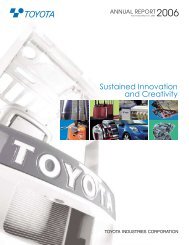
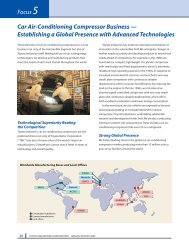
![PDF[476KB/5 pages] - Toyota Industries Corporation](https://img.yumpu.com/50288545/1/190x123/pdf476kb-5-pages-toyota-industries-corporation.jpg?quality=85)
![PDF[622KB/13pages] - Toyota Industries Corporation](https://img.yumpu.com/47399131/1/190x245/pdf622kb-13pages-toyota-industries-corporation.jpg?quality=85)
![PDF[792KB/2Pages] - Toyota Industries Corporation](https://img.yumpu.com/45510108/1/184x260/pdf792kb-2pages-toyota-industries-corporation.jpg?quality=85)
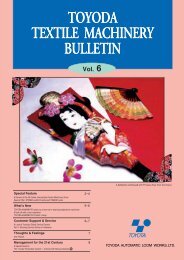

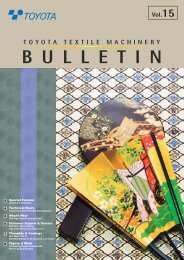
![PDF[126KB/4Pages] - Toyota Industries Corporation](https://img.yumpu.com/41525474/1/184x260/pdf126kb-4pages-toyota-industries-corporation.jpg?quality=85)
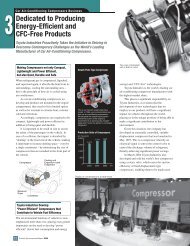
![PDF[1229KB/26 pages] - Toyota Industries Corporation](https://img.yumpu.com/40908773/1/190x247/pdf1229kb-26-pages-toyota-industries-corporation.jpg?quality=85)
